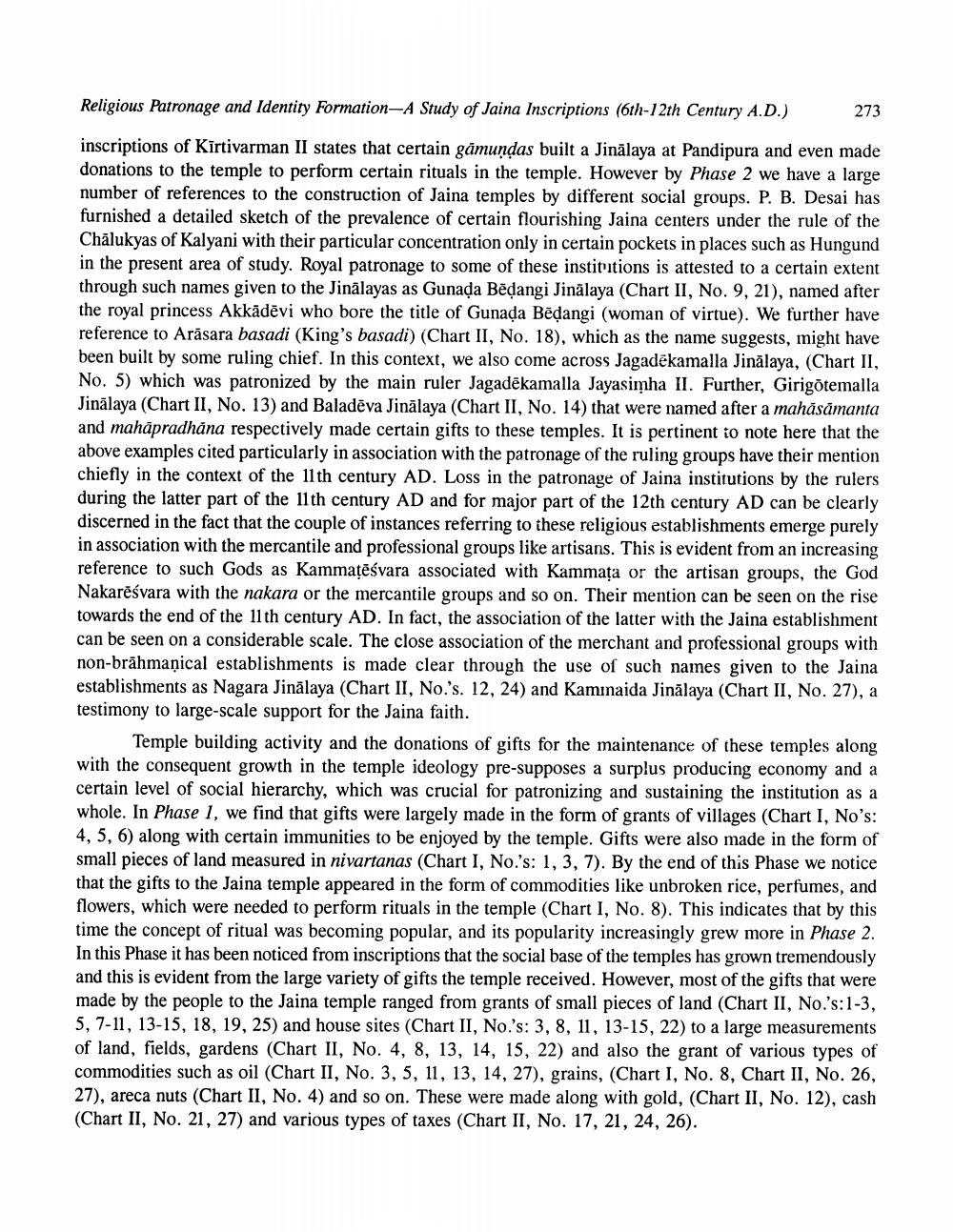________________
Religious Patronage and Identity Formation-A Study of Jaina Inscriptions (6th-12th Century A.D.)
inscriptions of Kirtivarman II states that certain gămundas built a Jinälaya at Pandipura and even made donations to the temple to perform certain rituals in the temple. However by Phase 2 we have a large number of references to the construction of Jaina temples by different social groups. P. B. Desai has furnished a detailed sketch of the prevalence of certain flourishing Jaina centers under the rule of the Chalukyas of Kalyani with their particular concentration only in certain pockets in places such as Hungund in the present area of study. Royal patronage to some of these institutions is attested to a certain extent through such names given to the Jinalayas as Gunaḍa Bedangi Jinalaya (Chart II, No. 9, 21), named after the royal princess Akkādēvi who bore the title of Gunada Bédangi (woman of virtue). We further have reference to Arasara basadi (King's basadi) (Chart II, No. 18), which as the name suggests, might have been built by some ruling chief. In this context, we also come across Jagadēkamalla Jinālaya, (Chart II, No. 5) which was patronized by the main ruler Jagadékamalla Jayasimha II. Further, Girigötemalla Jinalaya (Chart II, No. 13) and Baladeva Jinalaya (Chart II, No. 14) that were named after a mahasamanta and mahapradhana respectively made certain gifts to these temples. It is pertinent to note here that the above examples cited particularly in association with the patronage of the ruling groups have their mention chiefly in the context of the 11th century AD. Loss in the patronage of Jaina institutions by the rulers during the latter part of the 11th century AD and for major part of the 12th century AD can be clearly discerned in the fact that the couple of instances referring to these religious establishments emerge purely in association with the mercantile and professional groups like artisans. This is evident from an increasing reference to such Gods as Kammatesvara associated with Kammata or the artisan groups, the God Nakarēśvara with the nakara or the mercantile groups and so on. Their mention can be seen on the rise towards the end of the 11th century AD. In fact, the association of the latter with the Jaina establishment can be seen on a considerable scale. The close association of the merchant and professional groups with non-brahmanical establishments is made clear through the use of such names given to the Jaina. establishments as Nagara Jinälaya (Chart II, No.'s. 12, 24) and Kaminaida Jinalaya (Chart II, No. 27), a testimony to large-scale support for the Jaina faith.
273
Temple building activity and the donations of gifts for the maintenance of these temples along with the consequent growth in the temple ideology pre-supposes a surplus producing economy and a certain level of social hierarchy, which was crucial for patronizing and sustaining the institution as a whole. In Phase 1, we find that gifts were largely made in the form of grants of villages (Chart I, No's: 4, 5, 6) along with certain immunities to be enjoyed by the temple. Gifts were also made in the form of small pieces of land measured in nivartanas (Chart I, No.'s: 1, 3, 7). By the end of this Phase we notice that the gifts to the Jaina temple appeared in the form of commodities like unbroken rice, perfumes, and flowers, which were needed to perform rituals in the temple (Chart I, No. 8). This indicates that by this time the concept of ritual was becoming popular, and its popularity increasingly grew more in Phase 2. In this phase it has been noticed from inscriptions that the social base of the temples has grown tremendously and this is evident from the large variety of gifts the temple received. However, most of the gifts that were made by the people to the Jaina temple ranged from grants of small pieces of land (Chart II, No.'s: 1-3, 5, 7-11, 13-15, 18, 19, 25) and house sites (Chart II, No.'s: 3, 8, 11, 13-15, 22) to a large measurements of land, fields, gardens (Chart II, No. 4, 8, 13, 14, 15, 22) and also the grant of various types of commodities such as oil (Chart II, No. 3, 5, 11, 13, 14, 27), grains, (Chart I, No. 8, Chart II, No. 26, 27), areca nuts (Chart II, No. 4) and so on. These were made along with gold, (Chart II, No. 12), cash (Chart II, No. 21, 27) and various types of taxes (Chart II, No. 17, 21, 24, 26).




